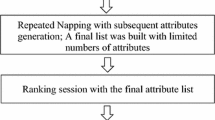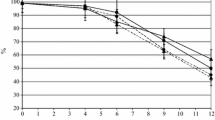Abstract
Grape must was fermented by a mixed culture of Saccharomyces cerevisiae W-3 (a wine yeast) and Issatchenkia orientalis KMBL 5774 (a malic acid-degrading yeast). Co-fermentation with 1:1 (v/v) inoculum ratio of W-3 and KMBL 5774 decreased malic acid to 0.33 mg/ml from 1.1 mg ml with W-3 alone. Ethanol production was the same in both cases (7.8%, v/v). Acetaldehyde, 1-propanol, 2-butanol and isoamyl alcohol all decreased, with an increase in methanol, in the co-fermented wine. Sensory evaluation showed a higher score in the wine fermented with 1:1 (v/v) inoculum ratio than those obtained by 4:1 (v/v) inoculum ratio or W-3 alone.



Similar content being viewed by others
References
Baranowski K, Radler F (1984) The glucose-dependent transport of l-malate in Zygosaccharomyces bailii. Antonie Van Leeuwenhoek 50:329–340
Bochner BR, Savageau MA (1976) Generalized indicator plate for genetic, metabolic and taxonomic studies with microorganisms. Appl Environ Microbiol 33:434–444
Caputi Jr A (1995) Wines. In: Cunniff P (ed) Official methods of analysis of AOAC international, 16th edn. AOAC International, Arlington, Virginia, USA, pp 28.1–28.16
Clemente-Jimenez JM, Mingorance-Cazorla L, Martinez-Rodriguez S, Heras-Viazquez FJL, Rodriguez-Vico F (2004) Molecular characterization and oenological properties of wine yeasts isolated during spontaneous fermentation of six varieties of grape must. Food Microbiol 21:149–155
Delcourt F, Taillandier P, Vidal F, Strehaiano P (1995) Influence of pH, malic acid and glucose concentrations on malic acid consumption by Saccharomyces cerevisiae. Appl Microbiol Biotechnol 43:321–324
Fatichenti F, Farris GA, Deiana P, Ceccarelli S (1984) Malic acid production and consumption by selected Saccharomyces cerevisiae under anaerobic and aerobic conditions. Appl Microbiol Biotechnol 19:427–429
Gallander JF (1977) Deacidification of eastern table wines with Schizosaccharomyces pombe. Am J Enol Vitic 28:65–68
Kim JS, Kim SH, Han JS, Yoon BT, Yook C (1999) Effects of sugar and yeast addition on red wine fermentation using Campbell Early. Kor J Food Sci Technol 31:516–521
Okuma Y, Endo A, Iwasaki H, Ito Y, Goto S (1986) Isolation and properties of ethanol-using yeasts with acid and ethanol tolerance. J Ferment Technol 64:379–382
Pretorius IS (2000) Tailoring wine yeast for the new millennium: novel approaches to the ancient art of winemaking. Yeast 16:675–729
Radler F (1993) Yeasts-metabolism of organic acids. In: Fleet GH (ed) Wine microbiology and Biotechnology, Harwood Academic, Chur, Switzerland, pp 165–182
Ruffner HP (1982) Metabolism of tartaric and malic acids in Vitis. Vitis 21:247–259
Seo SH, Rhee CH, Park HD (2007) Degradation of malic acid by Issatchenkia orientalis KMBL 5774, an acidophilic yeast strain isolated from Korean grape wine pomace. J. Microbiol 45:521–527
Schwartz H, Radler F (1988) Formation of L-malate by Saccharomyces cerevisiae during fermentation. Appl Microbiol Biotechnol 27:553–560
Taillandier P, Riba JP, Strehaiano P (1988) Malate utilization by Schizosaccharomyces pombe. Biotechnol Lett 10:469–472
Thornton RJ, Rodriguez SB (1996) Deacidification of red and white wines by a mutant of Schizosaccharomyces malidevorans under commercial winemaking conditions. Food Microbiol 13:475–482
Volschenk H, Viljoen M, Grobler J, Petzold B, Bauer F, Subden RE, Young RA, Lonvaud A, Denayrolles M, van Vuuren HJJ (1997) Engineering pathways for malate degradation in Saccharomyces cerevisiae. Nature Biotechnol 15:253–257
Volschenk H, Viljoen-Bloom M, Subden RE, van Vuuren HJJ (2001) Malo-ethanolic fermentation in grape must by recombinant strains of Saccharomyces cerevisiae. Yeast 18:963–970
Acknowledgements
This work was supported by a grant from the Korea Research Foundation (2004-005-F00063) and a research grant (203082-02-2-SB010) from the Ministry of Agriculture and Forestry, Korea.
Author information
Authors and Affiliations
Corresponding author
Rights and permissions
About this article
Cite this article
Kim, DH., Hong, YA. & Park, HD. Co-fermentation of grape must by Issatchenkia orientalis and Saccharomyces cerevisiae reduces the malic acid content in wine. Biotechnol Lett 30, 1633–1638 (2008). https://doi.org/10.1007/s10529-008-9726-1
Received:
Revised:
Accepted:
Published:
Issue Date:
DOI: https://doi.org/10.1007/s10529-008-9726-1




